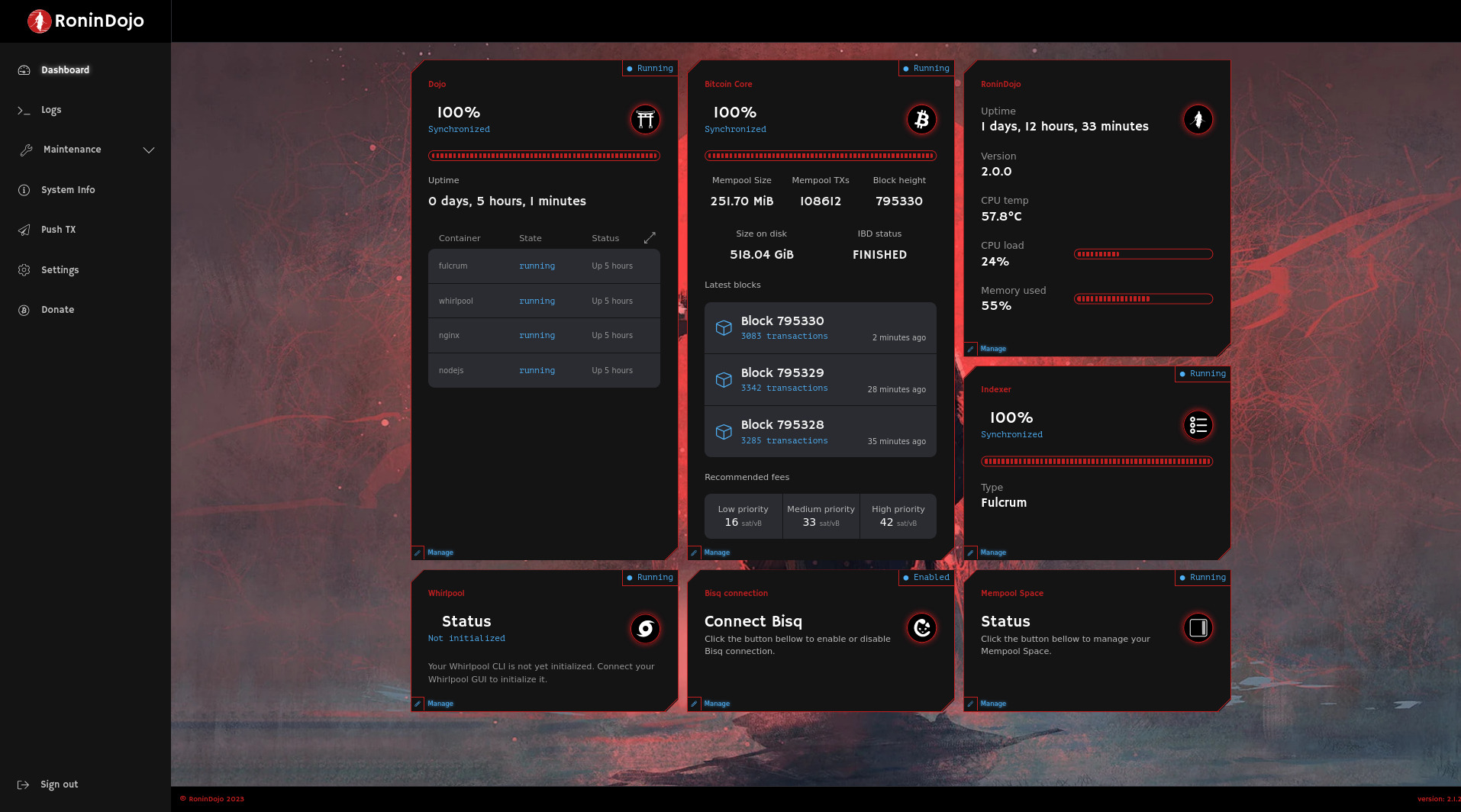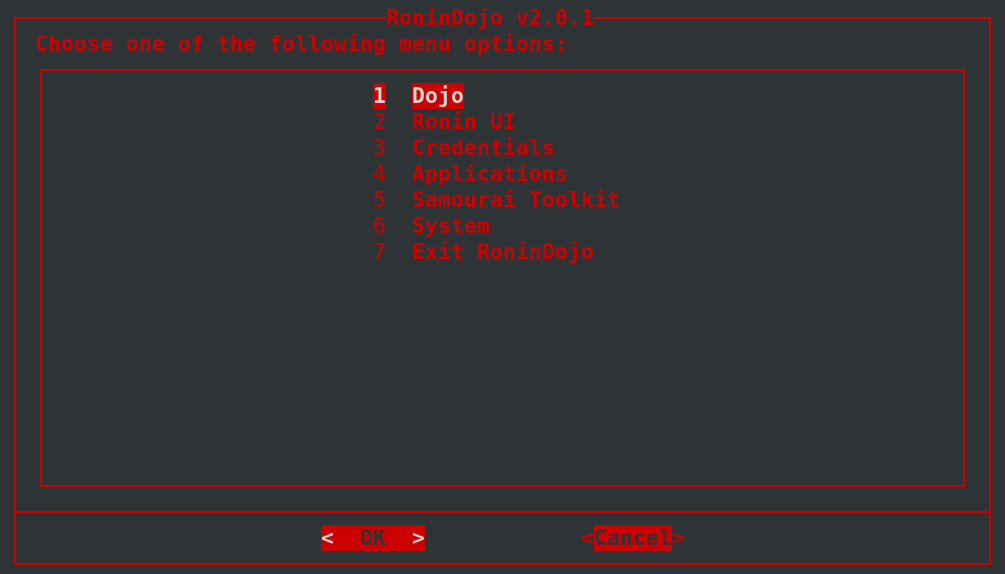¶ What is RoninDojo?
The main purpose of the RoninDojo software is quick and easy deployment of Samourai Dojo which is a privacy focused bitcoin node. There are many useful features packed into the RoninDojo project which can be explored on the Home Page.
If you are using a bitcoin wallet, it is important to be aware that behind every wallet is a bitcoin node. Think of the node as the "backend" to your wallet. Running a node allows you to maintain privacy and control when performing bitcoin transactions and removes the need to rely on third-party services. It also helps secure the network by validating transactions and blocks, which contributes to the overall health of the bitcoin blockchain.
Bitcoin is defined as "peer-to-peer version of electronic cash" that you can use "without going through a financial institution", and we hope to play our part in making this a reality with RoninDojo bitcoin nodes.
Keep up with the latest news about the RoninDojo project on our main website.
¶ Where can I donate?
See the Donate Page for more information.
¶ How do I troubleshoot my RoninDojo bitcoin node?
See the Troubleshooting Guide for RoninDojo users if you need help. The following links are examples of common troubleshooting.
- How do I turn on my Tanto?
- How do I reflash my Tanto?
- How do I salvage my data?
- My Tanto suddenly stopped working or lost power?
- What does the blue LED light on my Tanto mean?
- Why can't I access the RoninUI interface?
¶ Is the Tanto bitcoin node still for sale?
No, the Tanto bitcoin node product is currently out of stock and discontinued.
Currently you can build your own RoninDojo bitcoin node.
¶ What happened to Samourai Wallet?
Previously the RoninDojo team was the "exclusive hardware partner" of Samourai Wallet. To learn more about the arrest of the developers and support the ongoing case with donations, please see the Free Samourai Website.
What happened to the Samourai Wallet developers is wrong and unjust. Please consider supporting the cause by donating, sharing information on social media, and use the hashtag #FreeSamourai when posting.
The main RoninDojo Website has a detailed Blog post about the situation.
¶ How do I interact with my RoninDojo bitcoin node?
The RoninUI is our web based application designed to provide an easy way to interact with your RoninDojo bitcoin node.

¶ How do I update my RoninDojo bitcoin node?
RoninDojo nodes can be updated via the the RoninUI. A nofitcation banner will appear at the top of the user interface when an update is available.
Users familiar with command line menu can also use the RoninCLI to update by selecting the following.
System → Software Updates → Update RoninDojo
¶ Can I connect to my RoninDojo from anywhere?
Yes, many features of RoninDojo use the Tor network so you can utilize your RoninDojo privately and securely from anywhere in the world. For example try connecting to RoninUI over Tor or try connecting to Sparrow Wallet over Tor.
¶ Can I use my hardware wallet with RoninDojo?
Yes, we support many popular hardware wallets thanks to the Electrum Rust Server & Fulcrum Server features.
¶ Can I use other mobile or desktop wallets with RoninDojo?
Yes, we support all mobile and desktop wallets that integrate with Electrum Rust Server or Fulcrum Server.
¶ Can I run RoninDojo on my laptop/desktop?
Currently we only support the ARM architecture and spcifically support the Rockpro64 board.
¶ How do I access the command-line interface?
The power users will love our RoninCLI command-line interface! Some may prefer to have a simple point and click UI, but power users may need a little more control. Dive into the RoninCLI and find plenty of useful features.

¶ Do you support Lightning?
No, we do not plan on doing so at this time, and our focus is currently on base layer privacy. We can come back to this later pending adoption, privacy, and stability improvements for average node operator. Here is the current state of lightning network privacy and privacy related lightning proposals.
¶ Who were the Ronin?
The term "Ronin" refers to a masterless Samourai in feudal Japan. The word Ronin literally means "wave man," symbolizing their wandering status.
Musashi Miyamoto
One of the most legendary ronin in Japanese history is Musashi Miyamoto (1584–1645). This is the inspiration for our RoninDojo Logo. He is renowned as one of Japan's greatest swordsmen and is famous for his unique double-bladed swordsmanship and undefeated record in his 61 duels. Musashi was also a philosopher, strategist, and the author of "The Book of Five Rings," a classic text on strategy, tactics, and philosophy. His life as a ronin was marked by a quest for mastery in martial arts and a deep understanding of the principles of combat and life. Musashi's legacy continues to influence martial arts and popular culture today.
The 47 Ronin
The story of the 47 Ronin is one of the most famous tales in Japanese history and literature, symbolizing loyalty, honor, and revenge. The incident occurred in the early 18th century and is known as the Ako Incident.
The story begins with a samurai named Asano Naganori, who was provoked by a court official named Kira Yoshinaka. After being insulted and humiliated, Asano attacked Kira in the shogun's palace but was punished for his actions by being ordered to commit seppuku (ritual suicide). Asano's samurai, now masterless and known as ronin, vowed to avenge their lord's death.
Led by Oishi Yoshio, the leader of the 47 ronin, they meticulously planned their revenge over the course of nearly two years. They feigned disbandment and lived in obscurity to avoid suspicion. Finally, on a snowy night in December 1702, they launched a surprise attack on Kira's mansion, killing him and avenging their lord.
After their act of vengeance, the ronin surrendered to the authorities. They were given the choice to commit seppuku or face execution. All 47 chose to die honorably, and they were buried alongside their lord in a famous grave at Sengaku-ji Temple in Tokyo. The story of the 47 Ronin has been celebrated in various forms of art, including kabuki theater, films, and literature, and it remains a powerful symbol of loyalty and honor in Japanese culture.